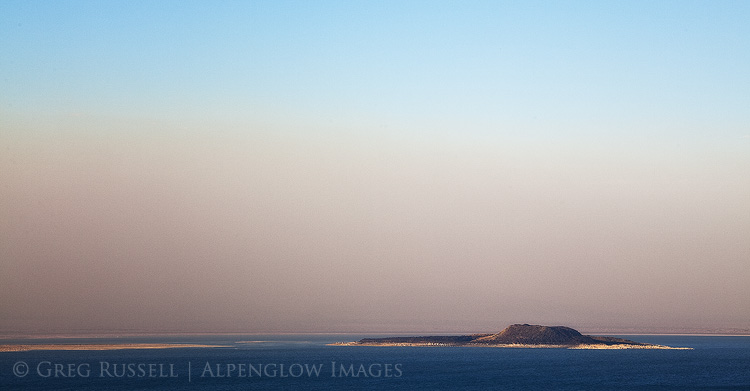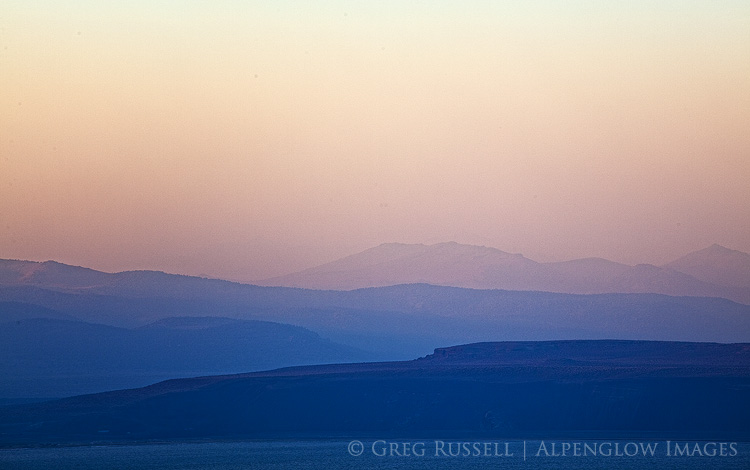This last weekend, my family and I visited the eastern Sierra for an event I was attending. We had a few extra hours on Saturday afternoon and decided to drive up to Tuolumne Meadows. On our way up Tioga Pass, I wondered if we would see any evidence of the Rim Fire. Highway 120, which connects Yosemite’s high country to the Valley is currently closed, so it was very quiet in Tuolumne Meadows, and as I expected, a very large smoke plume was evident across the western and northern skies. As evening arrived, the wind shifted and heavy smoke moved into Lee Vining Canyon, filling the Mono Basin.
Although it’s now 80% contained, the Rim fire has been burning since mid-August, and has charred over a quarter of a million acres, making it one of the most destructive fires in California’s history. Fire is becoming more and more a way of life in the West, but in the face of a blaze this size, outdoor enthusiasts, photographers, hikers, and simply the general public have stood in awe and horror as fire crews scrambled to get the upper hand in hot and dry conditions.
Unlike most people, when I think of Yosemite, I don’t think of the Valley. I think of Tuolumne Meadows and the granite domes, Mts. Dana and Gibbs and the Cathedral Range (one of my favorite mountain chains anywhere). This is the Yosemite I know. Standing there on Saturday, looking at the smoke, something didn’t feel right. I know I’m not alone in this feeling.
In the face of such destruction, whether it’s a forest fire or something more personal and human, we experience a visceral suffering. Pico Iyer had a wonderful op-ed piece in this Sunday’s New York Times, “The Value of Suffering,” in which he concludes that with love and trust, maybe we can be strong enough to witness suffering, and freely admit that we will never get the upper hand over it.
To put it another way, consider the interesting Japanese word nen. Nen is the smallest unit of time any human being can experience, and in any nen one can return to something, anything…whether it’s a breath, partner, path, or choice. This decision to return is the foundation of Zen practice.
In any nen–whether watching the Rim Fire from a distant Tuolumne Meadows or thinking about a loved one, we have the choice to return. I don’t want to distract from the mess that the Rim Fire has caused and allude to any single benefit, but we are an angry enough world as it is; it’s time to return to a more compassionate path and be thankful for the dew that covers the meadow each morning.



This is a very thoughtful and lovely post, Greg. Same goes for the images…beautiful.
Thanks, Steve, I appreciate it.
Nice post, sir. And Shiva the Destroyer always makes room for new life. Think of the wildflowers that will thrive, and all the new pine cones that have prepped for growth. I know that despite that knowledge, my heart is gonna ache when I see all that scorched land.
Thanks, Gary. I think you nailed the crux of all of this…while there is a lot of promise for recovery (sensu the 1988 Yellowstone fires), it is still very painful to see firsthand. I am learning more and more that the ability to embrace both sides of the coin, so to speak, is a pretty noble trait.
The article I link to above has a short poem by Kobayashi Issa (which is also where I got the title for this post):
This world of dew is a world of dew
And yet, and yet
Indeed…and yet.
Thanks again!
Fine post Greg…
Fire in itself isn’t a problem, as bad as it may look. It’s been an integral part of healthy forest life from the beginning.
In recent years though fire season has started earlier and lasted longer, the fires are more explosive and frequent and destructive. They’ve morphed from regenerative burns to destructive forces that are symptomatic of other serious imbalances. We’ll no doubt be looking at that scenario for a long time to come.
But… no despair here. Like Robert Service said, ” the wild must win in the end…”.
Very nice post Greg, and those are both fine fire weather images. I’ve watched a lot of fires in Idaho over the years with pretty good equilibrium, but the burns have New Mexico the last couple years have been harder emotionally, as they’ve hit some really special and fragile places that likely will not grow back the same. There’s a lot of country in the West that really needs some nice low-intensity burning to help clean it out, but as PJ says, those aren’t the fires we’re getting these days. I just have to hope that a lot of these areas will be recolonized by aspen groves.
Thanks for your comments, Jackson and PJ. Like you guys, driving around the West, I’m seeing undergrowth that has built up for decades in places (I remember seeing this very clearly on my visit to the Valles Caldera last fall), so it’s not really a surprise that the fires that do hit these areas are much more intense than what’s ecologically “right.” Combined with the ongoing drought and it makes for destructive burns like we’re seeing.
Although fire can be a very good thing for a forest, it’s difficult to watch what’s happening. Like Gary said, it’s acceptable to have a level-headed logical approach while still having a hurting heart over it all. I guess we take solace where we can find it.
In the wake of all of these fires, it will be very interesting to see the path that ecological succession takes.